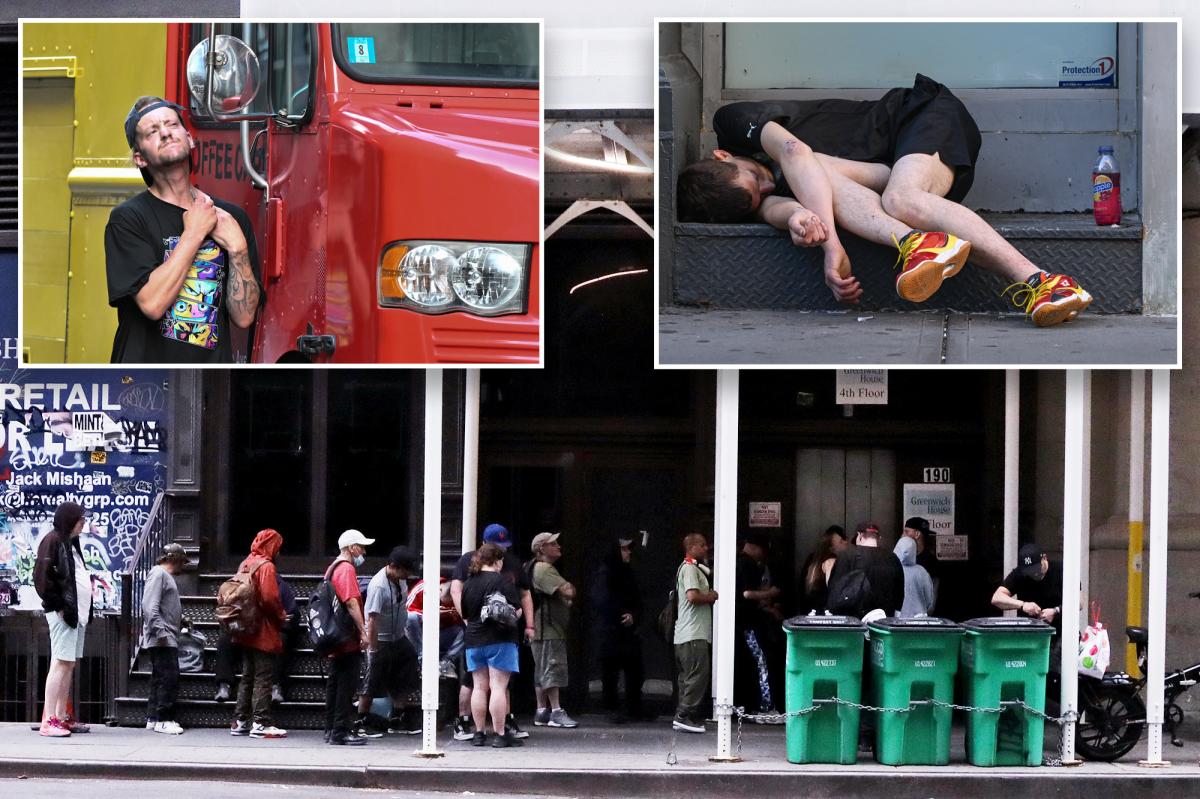Scenes from “Night of the Living Dead” are playing out a stone’s throw from the famed Angelika Film Center and A-lister apartments in NoHo, where zombified junkies and drug dealers have overtaken entire blocks.
At the heart of the problem is a $30 million taxpayer-funded nonprofit called Greenwich House, neighbors said, which employs a so-called “harm reduction” philosophy. Critics counter that it enables addicts rather than getting them to quit.
At its opioid clinic on Mercer Street, some 1,300 addicts are handed drugs like methadone – a narcotic given to help with withdrawal symptoms from stronger opioids like heroin — along with fentanyl test strips, which can detect the deadly chemical in drug supplies, and naloxone kits, which can reverse overdoses.
Each morning, addicts line up at 6 am as if queueing up for the latest iPhone drop.
The Post witnessed the depravity two days this week, with addicts contorted and splayed out on sidewalks and stoops, while others jabbed needles in their necks, arms and legs in broad daylight — as commuters and schoolkids warily walked by.
Other junkies collapsed on park benches, feet away from frolicking children, losing their shoes as they stumbled over. Another young man shuffled into moving traffic on West Houston, and was later seen kneeling on the pavement as medics tried to treat him.
Residents are fed up that their posh neighborhood – where a one-bedroom apartment recently sold for $2.2 million and celebs like Gigi Hadid live – has spiraled into a hellscape.
“Walking on Houston between Mercer and Crosby is an absolute disaster,” decried resident Linda Sondik.
“I have seen people being taken away in ambulances who clearly overdosed, and on the streets people are openly shooting up. It’s tragic and scary.”
Neighbor Lilly Migs said, “The kids will be playing in the playground and there’ll be people screaming and wailing on the other side.”
“Parents have called 911 and sometimes paramedics never show up.”
“I know the clinic is supposed to be helping people, but I don’t think they’re getting the help they need there,” she added.
“I think it’s unfortunately started to attract a different type of crowd. People that maybe do not want the help that they have to offer.”
The Post witnessed scores of dealers roaming the block, looking to take advantage of a vulnerable population.
“Every day, there are at least two or three overdoses, just around this corner,” said Hassane Elbaz, who’s run a coffee cart at the corner of Broadway and Houston for 25 years.
“Paramedics save a lot of them. But about every two months, one of them dies.”
Elbaz said there are seven or eight dealers just around his corner.
“See this guy – he has a fanny pack full of drugs,” he said pointing to a short older man dressed in black. “He’s the one who sells fentanyl. He killed four people in three days,” he claimed.
Part of the police’s inability to intervene stems from Albany’s move to decriminalize the possession and sale of needles in 2021. After that, junkies essentially had the green light to shoot up in public.
The taxpayer-subsidized clinic has been growing exponentially since the pandemic, and in the last six months, locals say things have gotten out of hand.
Greenwich House has been around since the 1970s – it was one of the city’s first methadone clinics. It pulls in close to $8 million a year in government funds – about a third of its budget – from both the city and state. Another large chunk comes from healthcare billing and Medicaid.
The nonprofit was running on a $15 million budget until around 2021 — when lefty politicians like Council Speaker Adrienne Adams, Manhattan Borough President Mark Levine and State Sen. Brad Hoylman-Sigal started backing it, appearing in glossy photo spreads in its annual reports.
From that time, the budget rose each year, financial statements show, doubling to almost $30 million by 2024.
Greenwich House also gets money from the family of far-left billionaire Democratic donor George Soros, with son Jonathan Soros and wife Jennifer are listed among the top donors in the organization’s latest annual report, giving $50,000 last year.
The clinic claims it offers care “through a harm-reduction framework, which means meeting people where they are on their journey to recover” – meaning not forcing them to quit until they decide they’re ready.
But the problem, critics say, is that’s not how addiction works.
“The idea is that people should only seek treatment when they’re ready. But most people addicted to drugs are addicted for their whole lives,” said Charles Fane Lehmann, a fellow at the Manhattan Institute.
“They often regard efforts to get people into treatment . . . as actively hostile to the interests of people who use drugs.”
A clinic spokeswoman contended “it is a common and unfortunate misconception that the presence of a treatment center causes public disorder. We are not the source; we are part of the response apparatus.”
Greenwich House’s executive director, Darren Bloch, was senior advisor to former Mayor Bill de Blasio and director of the mayor’s office of strategic partnership, before joining the organization in 2020. He made $230,000 in 2022, the last year for which Greenwich House made tax filings public.
It was under de Blasio that the Big Apple heralded the opening of the nation’s first two supervised injection sites in 2021, which progressive politicians promised would help address the surge in fatal overdoses across the city.
They have only continued to rise since.
About 2,300 New Yorkers died of drug overdoses last year – almost three times more than a decade ago, according to data from the state’s Health Department.
Most – about 1,650 people – died from fentanyl or other synthetic opioids. In comparison, 372 died of heroin and 188 died of pills like oxycodone.
